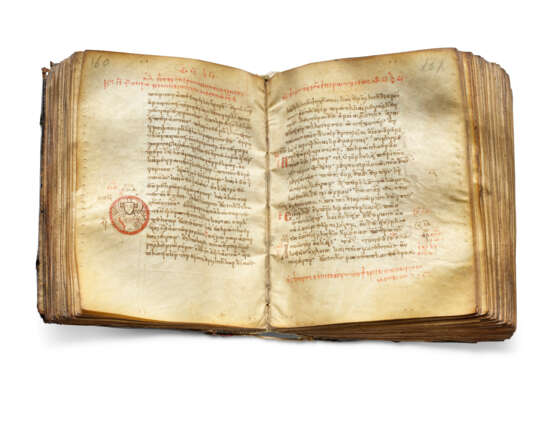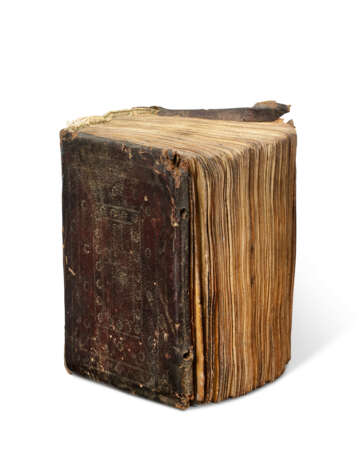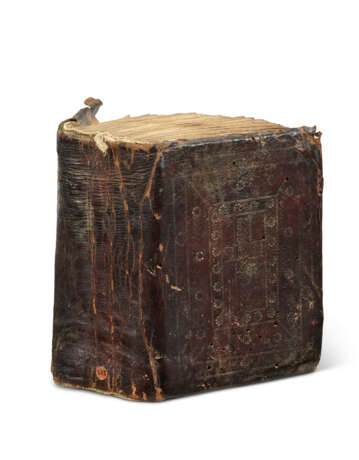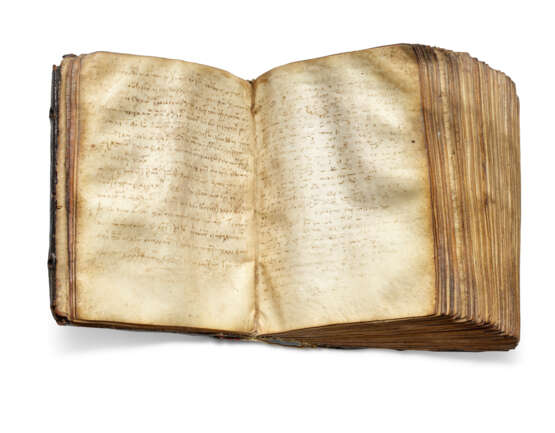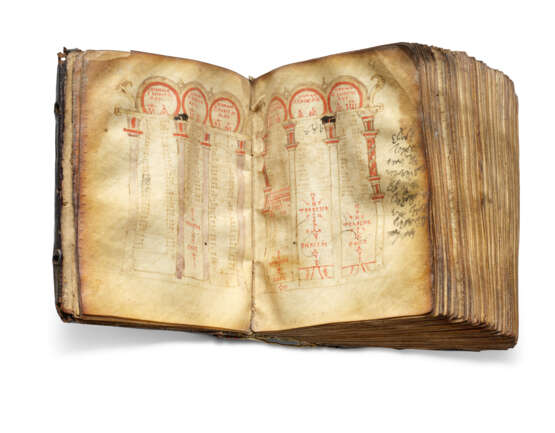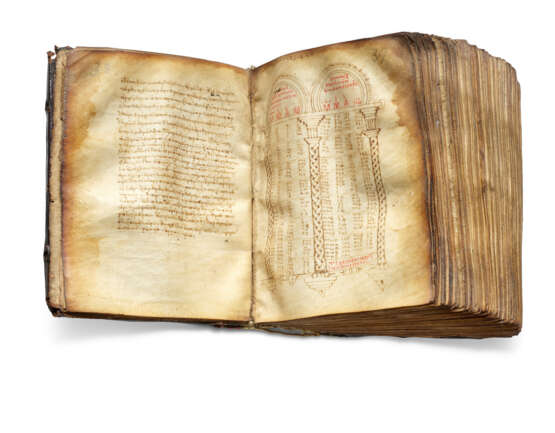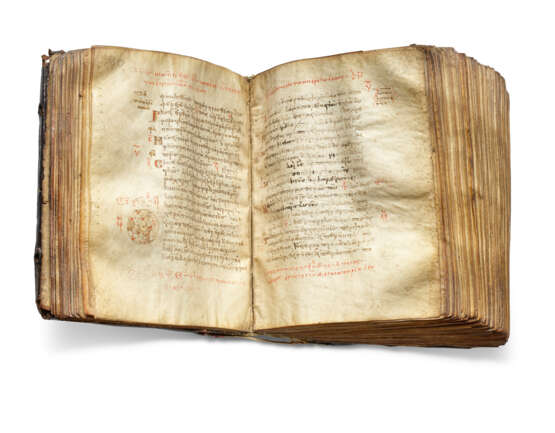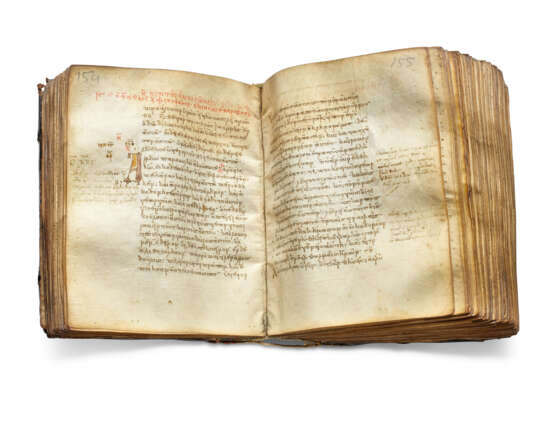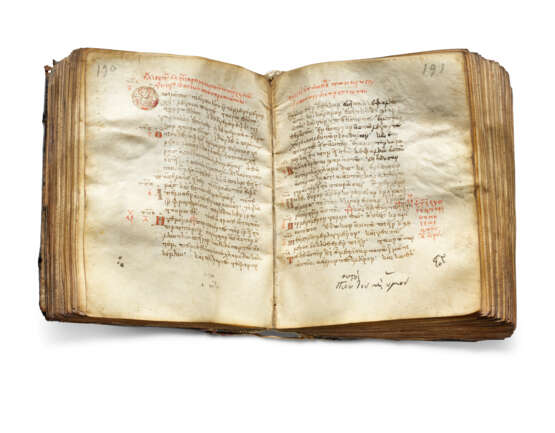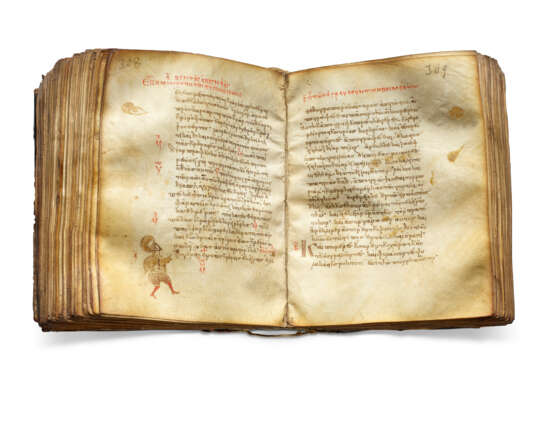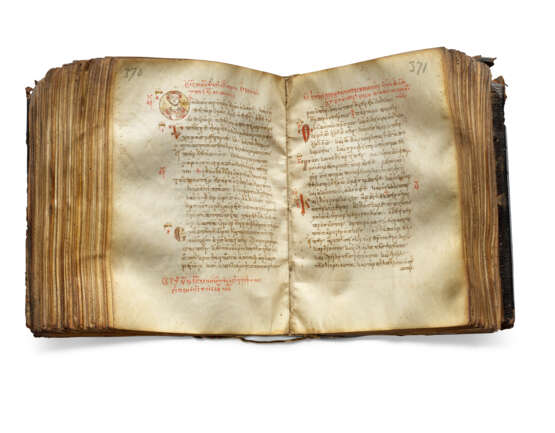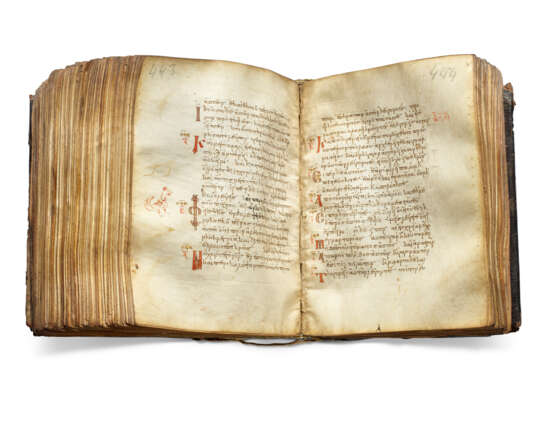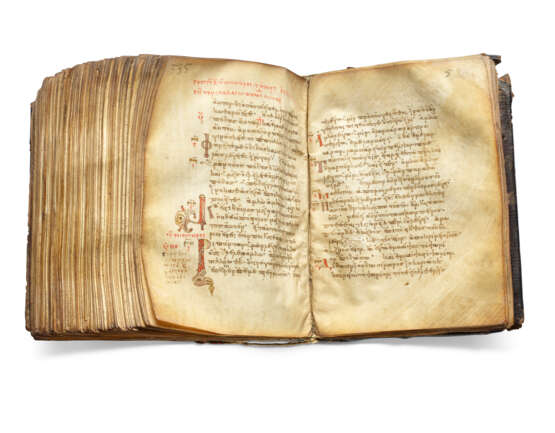ID 1214857
Lot 7 | The 'Charles of Anjou' Gospels
Estimate value
£ 200 000 – 300 000
Gospels, in Greek, decorated manuscript on vellum [southern Italy, 10th century]
An exceptional Greek Gospel Book from the 10th century, recorded by Aland as Greek minuscule 1421, produced in Greek-speaking southern Italy, and with 13th-century notes localising it to the court of Charles of Anjou, King of Naples and Sicily from 1266-1285.
150 x 123mm. 285 leaves, collation: 15 (of 8, lacking i-iii), 213 (of 16, lacking xiv-xvi), 37 (of 8, lacking v), 47 (of 8, lacking i), 5-68, 78 (of 10, lacking ii and viii), 88, 97 (of 8, viii a cancelled blank), 10-118, 127(of 8, lacking all but a stub of vii), 137 (of 8, lacking i), 146 (of 8, lacking i and viii), 158, 167 (of 8, lacking i), 177 (of 8, lacking i), 18-198, 204 (of 6, ii and iii cancelled blanks, vi cropped to a strip), 219 (viii, pp.311-2, an inserted singleton), 229 (vi, pp.327-8, an inserted singleton), 23-278, 287 (of 8, lacking all but a stub of iv), 29-308, 317 (of 8, lacking i), 32-368, 377 (of 8, lacking all but a stub of viii), 381 (of 4, lacking ii-iv, breaking off 27 verses from the end of the text and thus lacking 3 leaves of text), modern foliation in pencil 1-570 followed here (p.380 repeated), gathering signatures on first leaves, prickings survive, 20 lines written in a handsome Greek minuscule, ruled space: 91 x 65mm, preliminaries partly in two columns, headings in red uncials, nine pages entirely written in red uncials, painted initials throughout in ink and touched in red and yellow, 7 full-page Canon Tables within arcaded framing of columns, part of an interlace headpiece on p.299 inhabited by a bird, 9 small miniatures, eight of which in coloured roundels depicting Christ, one with a striding man in red socks, medieval annotations and additions throughout (lacking at least 21 leaves, thumbed and somewhat cockled, marginal staining, pp.99-100, 137-8 and 297-300 partly defective, some leaves with modern repairs and gutters strengthened, some leaves with horizontal cuts).
Binding:
Late medieval blind-stamped binding, possibly Italian, of wooden boards sewn 'alla Greca', sides panelled with double lines and stamped with repeated impressions of a small rosette and a small rectangular tool of 4 tiny saltires in squares (lacking clasps and catches, edges scuffed, worn and wormholed). Fitted box.
Provenance:
(1) The manuscript has been classified as Gregory-Aland 1421 and is datable to the 10th century. The text, style and decoration all indicate an origin in southern Italy in the 10th century and later inscriptions and binding show that it remained there for several centuries after its creation (see below). The strapwork decoration of the Canon tables is characteristic of southern Italian manuscripts such as the Gospel book in Vienna (ÖNB, Theo.graec.188); and the Greek minuscule, written with precise, compact, rounded forms and rectangular breathings (similar to British Library Add.MS.11300) is associable with the script of the so-called codices vetustissimi and codices vetusti of the ninth, tenth and eleventh centuries that was especially prevalent in early liturgical manuscripts.
(2) The manuscript was still in a monastic Greek-speaking community in the 13th century. A long entry in Greek on p.46, dated 14 July 1274, mentions the public notary Leo ('Τον ιουλιου μηνα. ινδικτιωνος α εις τας ιδ του ετους ςφπβ εσευε ο νοταριος Λεων του Σεμινης οικητωρ χωρας Βουνον Λεου') at the court of the most exalted King of Sicily ('η κωρτη του υψηλωτατου ριγος Σικαιλειας'). This is Charles of Anjou, King of Naples and Sicily from 1266-1285. Mention is also made of a Marthaios, of Calabria, and of the 'venerable priest' John of Lauletta ('τον ευλαβεστατον ιεραια Ιωαννην της Λαουλεττας'), and of the village of Venosa in Apulia. The manuscript appears to have been a gift to a monastery dedicated to the Birth of the Virgin ('το παρον του τετραβαγγελιου βιβλιον και ειδως αυτο ο ριθ εις νοταριος Λεων ετονισε και εξισεν το παρον της Θεοτοκου γεννησεως [...]'). On p.47 appears a troparion to be sung on the Feast of the Birth of the Virgin.
(3) By 1885 the manuscript had found its way to Mürefte (previously Myriophyton), in Turkey. Athanasios Papadopoulos-Kerameus (see Literature) notes that Gregorios Foteinos, then bishop of Mürefte (the same Foteinos who in 1865 served as abbot of the monastery of Nea Moni in Chios) showed him three privately owned manuscripts: the present manuscript is one of them. It was still in Mürefte when described by Soden in 1911, where it appears as his no 1421. By the time Aland describes it in 1963, it is 'früher: Myriophyton ['previously Myriophyton']'.
(4) Sotheby's, 19 June 1990, lot 79, purchased for £110,000 by:
(5) Schøyen Collection, MS 675.
Content:
Gospel Lections mostly for Saturdays and Sundays pp.1-14; Synaxarion with lists of Gospel lections arranged according to the liturgical calendar pp.15-35, added perhaps in the 11th century; the letter of Eusebius to Carpianus pp.37-8; Canon Tables pp.39-45; added inscriptions and a hymn to the birth of the Virgin in a 13th-centruy hand pp.46-7; Kephalaia for Matthew pp.48-50; Gospel of Matthew pp.51-199, opening at Matthew 1:12; Kephalaia for Mark pp.201-2; Gospel of Mark pp.203-91, opening at Mark 1:12; Kephalaia for Luke pp.293-7; Gospel of Luke pp.299-459; Kephalaia for John p.459; Gospel of John pp.460-569, beginning at John 1:16.
Literature
Aland, K., Kurzgefasste Liste der griechischen Handschriften des Neuen Testaments, I, 1963, no 1421, pp.136 and 413.
Papadopoulos-Kerameus, Α.,'Ἔκθεσις παλαιογραφικῶν καὶ φιλολογικῶν ἐρευνῶν ἐν Θράκῃ καὶ Μακεδονίᾳ κατὰ τὸ ἔτος 1885', Ὁ ἐν Κωνσταντινουπόλει Ἑλληνικὸς Φιλολογικὸς Σύλλογος, 1886, pp.5-6.
Soden, H., Freiherr von, Die Schriften des Neuen Testaments in ihrer ältesten erreichbaren Textgestalt hergestellt auf Grund ihrer Textgeschichte, 1911, no 1029, p.134.
| Place of origin: | Italy, Europe |
|---|---|
| Auction house category: | Medieval & renaissance manuscripts, Books and manuscripts |
| Place of origin: | Italy, Europe |
|---|---|
| Auction house category: | Medieval & renaissance manuscripts, Books and manuscripts |
| Address of auction |
CHRISTIE'S 8 King Street, St. James's SW1Y 6QT London United Kingdom | |
|---|---|---|
| Preview |
| |
| Phone | +44 (0)20 7839 9060 | |
| Buyer Premium | see on Website | |
| Conditions of purchase | Conditions of purchase |
